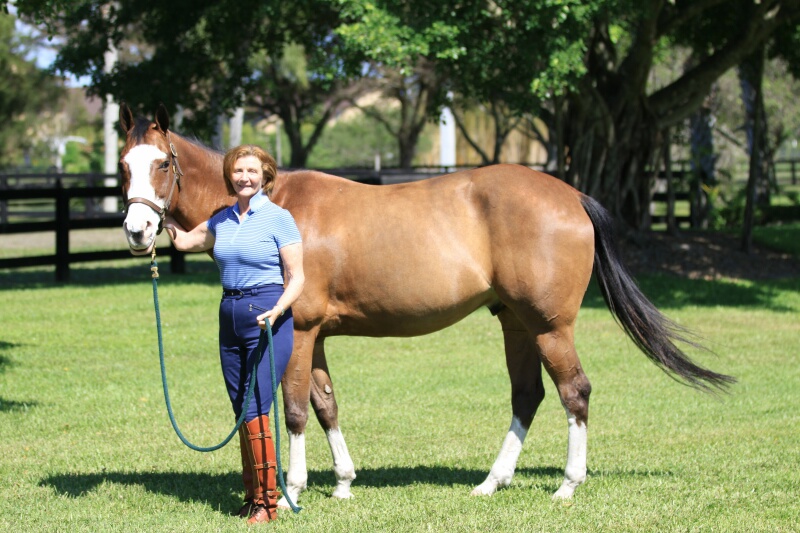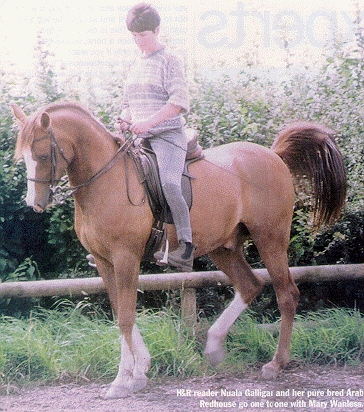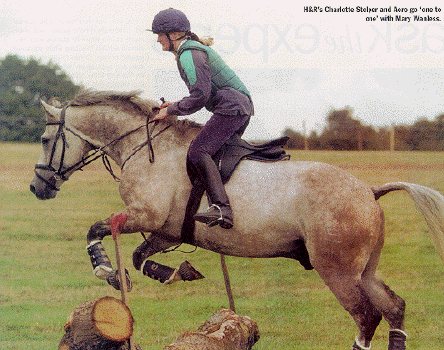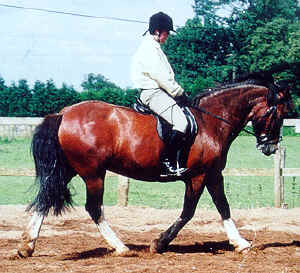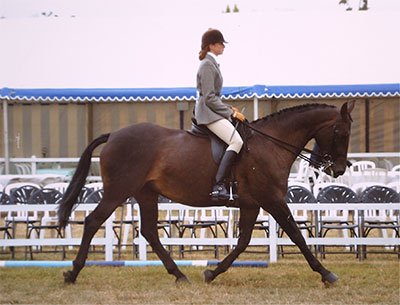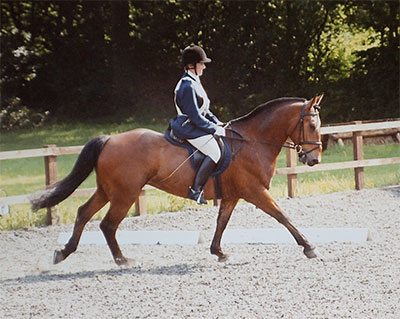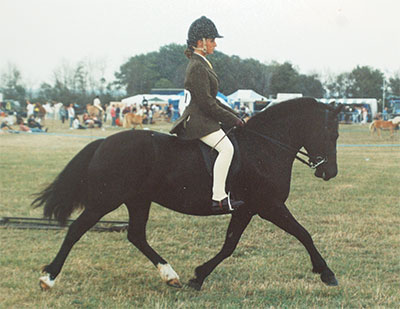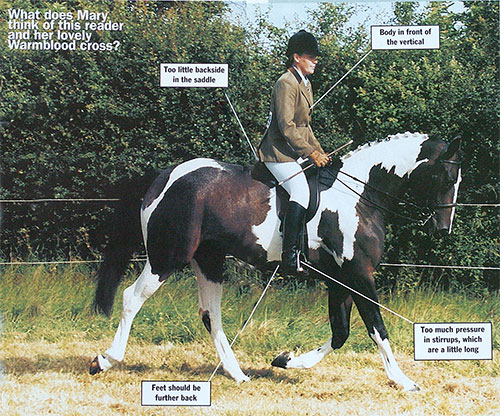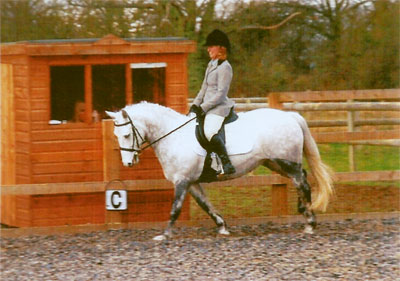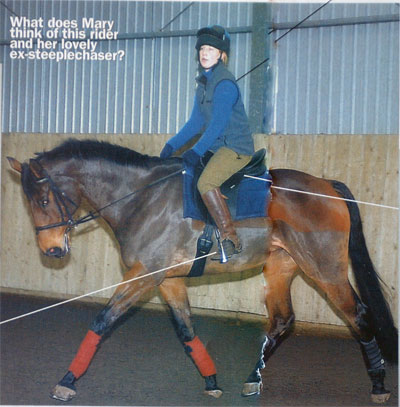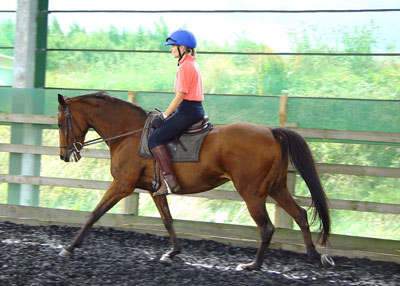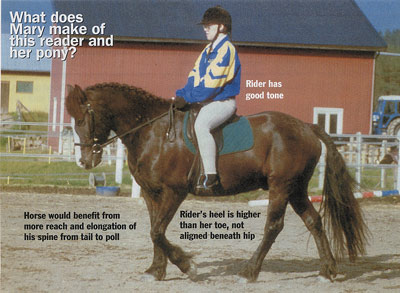RWYM
ARTICLE 7
 This photograph shows a five and a half year old mare, who is a Dutch Warm Blood X Thoroughbred. She was backed at three, turned away for a year, and started again at four. Her rider states that ‘we have had a few setbacks, with back/muscle problems resulting in some nappyness and a certain amount of ‘bouncing’, but this is hopefully now behind us’. She hopes to compete the mare in unaffiliated dressage and one day events.
This photograph shows a five and a half year old mare, who is a Dutch Warm Blood X Thoroughbred. She was backed at three, turned away for a year, and started again at four. Her rider states that ‘we have had a few setbacks, with back/muscle problems resulting in some nappyness and a certain amount of ‘bouncing’, but this is hopefully now behind us’. She hopes to compete the mare in unaffiliated dressage and one day events.
It immediately strikes one that the mare is very overbent. Yet the rider looks as if her body is organised well, with a good shoulder/hip/heel vertical line, and a good line to her spine, which is neither hollow nor rounded. If we took the horse out from under her by magic, she would land on the riding arena on her feet. Also, there is a nice integrity to her body: it does not look as if some bits are floppy whilst other bits are tight. Given that she shows this amount of rightness, what is going wrong?
I do not think that the rider herself is the cause of this problem, although she clearly does not have the tools in her ‘riding tool kit’ to neutralise it, and cause the horse to rebalance herself. This is a classic case of a horse who is on the forehand. If you ask yourself the question, ‘How would the horse land on the riding arena if we chopped her legs off?’ you’ll see that she would not plop neatly down onto the centre of her tummy, as a well-balanced horse would. Instead her shoulders and her nose would hit the ground first. Although the rider’s hands are in quite well placed, I suspect that her contact may be very strong. If we were to cut the reins, this horse would fall straight onto her knees and her nose!
I immediately find myself wondering if the muscle problems the rider has experienced with this horse were caused by this way of going, or whether they are the result of this way of going. This is like asking which is the chicken and which is the egg: does discomfort cause this way of going, or does this way of going cause discomfort? I wonder if the mare is protecting sore spots, or if she is creating sore spots – or whether she is actually doing both simultaneously.
Some riders assume that horses move in perfect balance until we get on their backs and ruin it all. Personally, I do not believe this is true. Some horses (the ones which I call the ‘walking wounded’) are physically compromised before we even get on them. But within the group who are robust, few horses move in the ideal balance, and some are naturally much better athletes than others. However, it is certainly true that we riders tend to create and compound difficulties rather than having the skills to resolve them, or even to improve the horse’s natural movement. (One of my friends likes to say that there are five types of trot; collected trot, working trot, medium trot, extended trot and expensive trot; but if you are a skillful enough rider you can improve any horse’s trot and canter, making them look far more expensive than they actually are!)
I suspect that this horse’s free movement would also show the pattern that we see here, and that she habitually pulls herself along with her forelegs instead of pushing herself along with her hind legs. She looks to be a very long horse, whose back behind the saddle is very weak. In this picture, she is nowhere near tracking up, and I suspect that it would take very good riding to bring her hind legs far enough underneath her for this to happen. Also, her wither appears to be lower than her croup, which never helps. But there is more to this problem than conformation, and I suspect that the horse has an investment in preserving the status quo.
I think that this rider will need the help of a very skilful rider and teacher if she is to ‘call the horse’s number’. If I were to get on this horse, the first few moments would be spent assessing the situation; but even then, I would be attempting not to play the horse’s game and to take up a strong contact. Every time she began to lean on my hand, I would have to make this impossible for her by giving her nothing she can lean on. But at the same time, I would also have to hold my body very correctly, because lightness only becomes possible when I can also influence her torso.
The bottom line is that the horse’s head functions like a weight on the end of a long pole (the neck). She has to use the muscles around her shoulder blade, her wither and her back to counterbalance this weight. If she refuses to do this, the job of holding up the weight of the head becomes delegated to the rider. If you hold onto something reasonably heavy and put your arm out in front of you at shoulder height, you do not have to keep it there very long before you realise how hard the muscles around your shoulder and the top of your upper arm are having to work. So it is with the horse who works correctly, using his own muscle power to hold up his head. It is this muscle-use which develops the horse’s top line, creating that beautiful curve from wither to poll. For whatever reasons of her own, this horse is avoiding that muscle-work like the plague; the upper part of her crest curves too much, and the muscles in her back and the base of her neck are not functioning well.
In this kind of situation I liken the horse to one of those hour glass egg timers in which sand passes from one compartment into the other. But imagine the egg timer lain on its side, with one compartment being the horse’s ribcage, and the other being his head.
I as rider want the sand in the horse’s body, so that it fills out his back underneath me, making it feel as if I am sitting on an inflated balloon. The back muscles will then be working correctly, and the head will remain ‘empty’, i.e. light in my hand. But the horse wants to keep this balloon deflated, and to keep the sand in her head. (The third possibility is that the sand drops down into the horse’s tummy, as it does in the hollow backed horse whose ears come back towards your chin, but that is unlikely to happen with this horse.) So I, as rider, have to be able to ‘hold the sand in the horse’s back’ with my body, whilst refusing to ‘hold up the sand in her head’ with my hand.
Every time the horse tries to make the contact heavier, imagine how the sand might go ‘whoosh’, passing from under my thigh and backside into her head. But I must not let this happen! Neither my torso nor my hand must ‘play her game’. I can also use walk/halt transitions to respectfully confront her pattern: I have to use the ‘passive resistance’ which I expand in last month’s article, and refuse to make the oh-so-common mistakes of leaning back, growing tall, pulling my stomach in, and pushing down harder into the stirrups – some or all of which will always accompany pulling on the reins.
Every time I make one of these mistakes, the horse will be in seventh heaven. ‘I’ve got you!’ she’ll tell me, as I pull back against her and she pulls down against me, reinforcing the status quo. It will take quiet, determined, skilful riding to say, ‘Sorry, I’m not going to play that game’, and to maintain so much rightness that you, as rider, do not become embroiled in the horse’s wrongness. Then, as the horse is forced to take responsibility for carrying her own head and neck, so her shape will change. Her back will ‘fill out’, developing muscle, and transferring her engine to her hind legs, which then push her along. But given this horse’s history, I would like to know that a physiotherapist, chiropractor and/or massage therapist has given her a clean bill of health before I challenged her to make these changes.
As I said earlier, I think our rider will need skilful help with this horse. But I have found on many occasions, that just giving riders the idea that the sand can be either in the horse’s back or in the horse’s head has enabled them to make a significant difference to his carriage. As I keep asking them ‘And where’s the sand now?’ they begin to think in more helpful ways, and to give with the hand whilst they ‘hold’ with the pelvis and thigh. The muscles in their thigh, pelvis and abdomen will have to work extremely hard to cause the horse to work the muscles in his thighs pelvis and abdomen much harder. But the pay-off for the effort is enormous.

